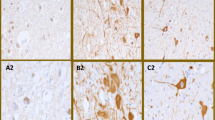Abstract
Ataxia with oculomotor apraxia type 1 (AOA1) is a rare autosomal recessive neurodegenerative disease, recently associated with mutations in the aprataxin gene. Main features are early onset cerebellar ataxia, oculomotor apraxia and peripheral neuropathy. The presence of choreoathetosis or dystonia in some patients suggests basal ganglia involvement, but these structures appear preserved in a single case in which neuropathological examination was performed. To evaluate in vivo the nigrostriatal function we studied dopamine transporter (DAT) density with [123I] 2beta-carbometoxy-3beta-(4-iodophenyl)-N-(3-fluoropropyl) nortropane (FPCIT)-SPECT in four AOA1 patients and eight healthy volunteers. All patients showed ataxia and neuropathy; only one had chorea and none had dystonia. Comparing with controls, AOA1 patients showed a slight reduction of the average striatal DAT density, which was bilateral and uniform in caudate and putamen. Nigrostriatal impairment occurred even in the absence of extrapyramidal features. Our data suggest subclinical involvement of basal ganglia in AOA1.
Similar content being viewed by others
References
Barbot C, Coutinho P, Chorao R, et al. (2001) Recessive ataxia with ocular apraxia: review of 22 Portuguese patients. Arch Neurol 58:201–205
Cardoso F, Seppi K, Mair KJ, et al. (2006) Seminar on choreas. Lancet Neurol 5:589–602
Criscuolo C, Mancini P, Menchise V, et al. (2005) Very late onset in ataxia oculomotor apraxia type I. Ann Neurol 57:777
Criscuolo C, Mancini P, Sacca F, et al. (2004) Ataxia with oculomotor apraxia type 1 in Southern Italy: late onset and variable phenotype. Neurology 14(63):2173–2175
Date H, Onodera O, Tanaka,H, et al. (2001) Early-onset ataxia with ocular motor apraxia and hypoalbuminemia is caused by mutations in a new HIT superfamily gene. Nature Genet 29: 184–188
Ginovart N, Lundin A, Farde L, et al. (1997) PET study of the pre- and postsynaptic dopaminergic markers for the neurodegenerative process in Huntington’s disease. Brain 120:503–514
Gunther P, Storch A, Schwarz J, et al. (2004) Basal ganglia involvement of a patient with SCA 17 – a new form of autosomal dominant spinocerebellar ataxia. J Neurol 251:896–897
Le Ber I, Moreira MC, Rivaud-Pechoux S, et al. (2003) Cerebellar ataxia with oculomotor apraxia type 1: clinical and genetic studies. Brain 126:2761–2772
Moreira MC, Barbot C, Tachi N, et al. (2001) The gene mutated in ataxiaocular apraxia 1 encodes the new HIT/Zn-finger protein aprataxin. Nat Gene 291:189–193
Sekijima Y, Hashimoto T, Onodera O, et al. (2003) Severe generalized dystonia as a presentation of a patient with aprataxin gene mutation. Mov Disord 18:1198–1200
Sekijima Y, Ohara S,Nakagawa S, et al. (1998) Hereditary motor and sensory neuropathy associated with cerebellar atrophy (HMSNCA): clinical and neuropathological features of a Japanese family. J Neurol Sci 158:30–37
Shimazaki H, Takiyama Y, Sakoe K, et al. (2002) Early-onset ataxia with ocular motor apraxia and hypoalbuminemia: the aprataxin gene mutations. Neurology 27(59):590–595
Tranchant C, Fleury M,Moreira MC, et al. (2003) Phenotypic variability of aprataxin gene mutations. Neurology 11; 60:868–870
Trouillas P, Takayanagi T, Hallet M, et al. (1997) International cooperative ataxia rating scale for pharmacological assessment of the cerebellar syndrome. J Neurol Sci 145:205–211
Salvatore E, Varrone A, Sansone V, et al. (2006) Characterization of nigrostriatal dysfunction in spinocerebellar ataxia 17. Mov Disord 21:872–875
Varrone A, Salvatore E, De Michele G, et al. (2004) Reduced striatal [123I]FPCIT binding in SCA2 patients without parkinsonism. Ann Neurol 55:426–430
Author information
Authors and Affiliations
Corresponding author
Rights and permissions
About this article
Cite this article
Salvatore, E., Varrone, A., Criscuolo, C. et al. Nigrostriatal involvement in ataxia with oculomotor apraxia type 1. J Neurol 255, 45–48 (2008). https://doi.org/10.1007/s00415-007-0657-x
Received:
Revised:
Accepted:
Published:
Issue Date:
DOI: https://doi.org/10.1007/s00415-007-0657-x




